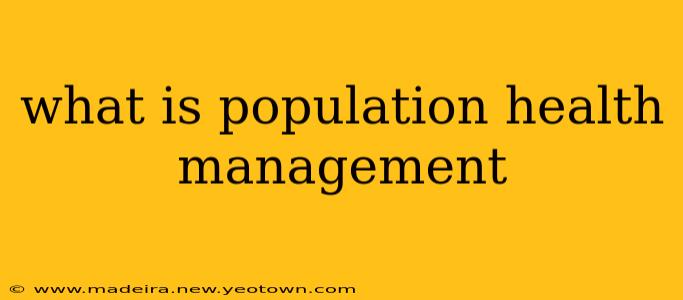What is Population Health Management? A Story of Prevention and Proactive Care
Imagine a world where healthcare isn't just about treating illness, but preventing it altogether. That's the promise of population health management (PHM). It's not about individual doctor visits; it's about looking at the health of entire communities and taking proactive steps to improve the well-being of everyone. Think of it as a shift from treating the sick to keeping the population healthy.
This isn't a new concept. For centuries, public health initiatives have focused on preventing disease through things like sanitation improvements and vaccination programs. PHM builds on this foundation, but with a more sophisticated, data-driven approach. It uses technology and data analysis to identify trends, predict potential health crises, and tailor interventions to specific groups within a population.
Let's paint a picture. Imagine a small town grappling with a rising rate of diabetes. A traditional approach would be to treat individuals as they develop the disease. But with PHM, healthcare providers would analyze data – looking at factors like diet, access to healthy food, socioeconomic status, and even the prevalence of diabetes in families – to identify high-risk individuals before they develop diabetes. They'd then implement targeted programs: promoting healthy eating habits through community workshops, offering affordable gym memberships, or providing diabetes education and support groups.
This proactive approach is more cost-effective in the long run and leads to better overall health outcomes. It's less about reactive care and more about preventative wellness.
What are the key goals of Population Health Management?
The core goal of PHM is to improve the health of a defined population. This is achieved through a multi-pronged approach, encompassing:
- Reducing healthcare costs: By preventing illness and managing chronic conditions effectively, PHM aims to reduce the overall burden on the healthcare system.
- Improving patient outcomes: This involves better disease management, increased life expectancy, and improved quality of life.
- Enhancing patient engagement: PHM emphasizes proactive communication and collaboration between patients and healthcare providers to improve adherence to treatment plans.
- Improving health equity: Addressing disparities in access to care and health outcomes among different population groups is a crucial aspect of PHM.
How does Population Health Management work in practice?
PHM isn't a one-size-fits-all solution. The specific strategies employed will vary depending on the specific population and their unique needs. However, several key elements are common across various PHM models:
- Data analytics: Collecting and analyzing data from various sources (electronic health records, claims data, wearable technology) to identify patterns and trends in health outcomes.
- Risk stratification: Identifying individuals at high risk of developing specific conditions.
- Targeted interventions: Developing and implementing customized programs and interventions for different risk groups.
- Care coordination: Ensuring seamless communication and collaboration among healthcare providers, patients, and other stakeholders involved in a patient's care.
- Performance measurement: Tracking and evaluating the effectiveness of PHM initiatives to ensure they are achieving their goals.
What are the benefits of Population Health Management?
The benefits are numerous and far-reaching. Let's explore some key advantages:
- Improved patient health: PHM leads to better health outcomes, preventing disease and improving the management of chronic conditions.
- Reduced healthcare costs: By preventing illness and managing chronic conditions effectively, PHM contributes to lower healthcare expenditures.
- Enhanced patient engagement: PHM encourages patients to take a more active role in managing their own health.
- Better care coordination: PHM improves communication and collaboration among healthcare providers.
- More efficient use of resources: PHM helps optimize the allocation of healthcare resources to maximize their impact.
What are the challenges of Population Health Management?
While PHM offers significant advantages, it also presents several challenges:
- Data integration and interoperability: Combining data from various sources can be technically challenging.
- Privacy and security concerns: Protecting patient data is paramount.
- Cost of implementation: Implementing PHM programs can require significant upfront investment.
- Lack of skilled workforce: Managing PHM programs requires specialized skills and expertise.
What technologies are used in Population Health Management?
Modern PHM relies heavily on technology:
- Electronic Health Records (EHRs): Central repositories of patient information.
- Data analytics platforms: Tools to analyze large datasets and identify trends.
- Predictive modeling: Algorithms to forecast potential health risks.
- Remote patient monitoring devices: Wearables and other technologies that track patient health data remotely.
- Telehealth platforms: Facilitating remote communication and care delivery.
In conclusion, population health management is a paradigm shift in healthcare, moving from reactive treatment to proactive prevention. It's a complex undertaking, but the potential benefits – healthier populations and more efficient healthcare systems – are immense. As technology continues to evolve, we can expect PHM to play an even larger role in shaping the future of healthcare.

